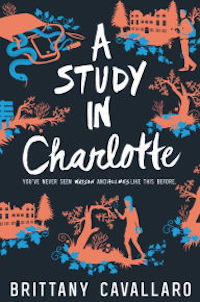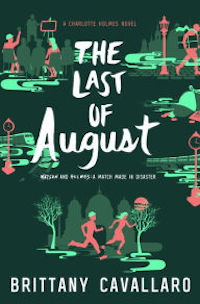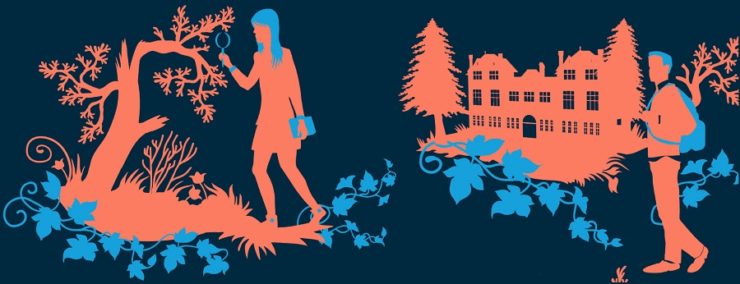Are you a Sherlock Holmes geek? Like contemporary retellings of literary classics? Crave tense, sharp-edged YA that eschews trope-y trappings? Well then, have I got a series for you! Brittany Cavallaro’s Charlotte Holmes trilogy is a dark and twisty YA mystery series where everyone is more than what they seem but less than they think they are. The third book won’t be published until 2018, but you shouldn’t wait until then to devour the first two.
In the world of Cavallaro’s series, Watson and Holmes were real people. However, the public still mostly knows them from the partly fictionalized accounts scribed by Watson. Today, the Watson family has largely abandoned fame and fortune for a solid middle-class life in the ‘burbs. The Holmes and Moriarty families, on the other hand, have become intensified versions of their more infamous namesakes. Charlotte’s parents are even more condescending and emotionally distant than Sherlock, and the current crop of Moriartys make their predecessor look positively twee.
We first meet Jamie Watson and Charlotte Holmes, the direct descendants of James Watson and Sherlock Holmes, in A Study in Charlotte. Jamie is sent from his mother’s flat in London to Sherringford, a private Connecticut boarding school not far from his father’s house, on a rugby scholarship. As punishment for dragging her family name through the tabloids, Charlotte is also sent to Sherringford, and there the teens collide. In the first book, Charlotte is framed for the murder of a classmate and Watson insists on helping her clear her name, partly because of the thrill of playing the parts of “Watson” and “Holmes” but mostly because of his growing crush on his cigarette smoking, violin playing, mad scientist of a companion. Things get bad, then worse, then even worse.
The Last of August, book two, opens shortly after the end of the first book, with Jamie and Charlotte spending the Christmas holiday in cheery old England. At her parents’ country estate, Jamie learns the icy depths of Charlotte’s personality and must decide if pursuing a romantic relationship is worth the probable loss of her friendship. The Moriartys reappear just as Charlotte’s beloved uncle Leander goes missing during a break from an undercover art forgery sting. Their search drags them through the gritty Berlin underground art scene, across the bleak landscape of lost hope, poisonous fears, and violent rejection, and straight into the clutches of a psychotic killer. It ends in a tragic and unexpected murder, an act which could either push Charlotte and Jamie closer together or irrevocably rip them apart.
 The Charlotte Holmes trilogy isn’t your typical YA murder mystery series. Paying homage to Doyle, Cavallaro fills her series with plenty of wild Sherlockian deductions and suspicious red herrings. The first mystery is pretty straightforward but the second is a little too over the top and convoluted. Nevertheless, it’s edge-of-your-seat action and nail-biting drama all the way through. Cavallaro doesn’t pull any punches with her plot, and her text is just as powerful. It bobs and weaves, crafting sentences in evocative ways and unfolding layers of history in a single line. Her skill as a writer goes a long way to mask some of the looming flaws—the action can sometimes have so many moving pieces that the whole thing gets muddled, characters not Jamie and Charlotte need a little more shading in, and the cast is nearly entirely straight and white—but even if the plot sucked and the characters were unappealing, Cavallaro’s writing would still make the series worth reading.
The Charlotte Holmes trilogy isn’t your typical YA murder mystery series. Paying homage to Doyle, Cavallaro fills her series with plenty of wild Sherlockian deductions and suspicious red herrings. The first mystery is pretty straightforward but the second is a little too over the top and convoluted. Nevertheless, it’s edge-of-your-seat action and nail-biting drama all the way through. Cavallaro doesn’t pull any punches with her plot, and her text is just as powerful. It bobs and weaves, crafting sentences in evocative ways and unfolding layers of history in a single line. Her skill as a writer goes a long way to mask some of the looming flaws—the action can sometimes have so many moving pieces that the whole thing gets muddled, characters not Jamie and Charlotte need a little more shading in, and the cast is nearly entirely straight and white—but even if the plot sucked and the characters were unappealing, Cavallaro’s writing would still make the series worth reading.
This isn’t a straight up modern update or contemporary retelling of the Doyle classics. Callbacks abound, but she’s done something quite apart from him. A Study in Charlotte takes inspiration from The Adventure of the Speckled Band, but only generally; The Last of August is even less connected to canon and effectively blows up what’s left of the Holmes/Watson/Moriarty romantic mythos. If A Study in Charlotte acknowledges that its protagonists don’t deserve their sacred places high up on a pedestal, The Last of August knocks them down into the mud. The first book pulls away the glamor and charm to reveal the flawed people underneath, and the second unveils the cruel extent they’ll go in order to maintain their crumbling facades.
The roles of certain characters still exist from Doyle to Cavallaro—Charlotte and Jamie as the complementary opposites Holmes and Watson, Milo Holmes as haughty desk jockey Mycroft, Detective Shepard as put-upon LeStrade, sundry Moriartys as clones of the Napoleon of crime himself, August Moriarty playing the clever yet trapped Irene Adler, and Lena as the amiable Mrs. Hudson. But thankfully Cavallaro lets them roam beyond Doyle’s constrained parameters. While the original James Watson had, to paraphrase Sherlock Holmes, a grand gift of silence which made him invaluable as a companion, Jamie Watson never knows when to shut up. Charlotte, on the other hand, is a vast ocean of complexities and contradictions. Even her nuances have nuances. Of course, Charlotte and Jamie hit all of the same mile markers as their ancestors, but the real heart of the matter is how they react to their Doyle-ian inspired traits—real, imagined, and idealized—and how those traits come into conflict with the attitudes and mores of 21st century teenagers.
There is, of course, the requisite love triangle, but I can’t really discuss it in detail without spoilers. Suffice it to say, Cavallaro subverts the trope with vicious flair in A Study in Charlotte, then shatters what remains of it in The Last of August. Jamie and Charlotte are the main two points to the triangle, but theirs isn’t an easy love. Hell, there might not even be a romance if they can’t come to an accord over Charlotte’s past and what role Jamie plays in her future.
Because the narration is from Jamie’s POV—he keeps a journal of his interpretation of the events just like his great-great grandfather did—we’re as much in the dark as he is when it comes to both the bloodthirsty puzzles and the inner workings of Charlotte. It’s not just because Jamie isn’t able to put the pieces together as quickly as she (although that’s a big part of it, to be sure), but also because he fundamentally misunderstands her. Midway through the second novel he turns the narration over to Charlotte. Jamie romanticizes his relationship with Charlotte, whereas she frames it from a more introspective and pragmatic perspective:
I always felt as though he wanted us to reach a solution, as though he and I were a mathematical proof that simply needed to be balanced. For a very long time, I thought he considered me to be the problem, and then I worried he thought that I was the solution. I’m neither. I’m a teenage girl. He is my boy best friend. We would be everything to each other until we couldn’t … Jamie was the only escape from myself I’d ever found. When I was beside him, I understood who I was. I spoke to him, and I liked the words I said. I spoke to him, and the words he said back surprised me. Sharpened me … Jamie showed me myself made better. He was loyal and kind, stalwart, like the knights from the old tales, and yes, he was handsome, even with a bruised face and a furrowed brow, miles away from the place we met or from the places we called home.
 The only real source of disappointment for me was the revelation that Charlotte is heterosexual. Before you get out the torches, let me explain. Until Charlotte literally stated her sexual orientation late into The Last of August, it seemed pretty obvious to me that she was demisexual and heteromantic. For those who don’t know, demisexual fits snugly under the asexual umbrella. Although it’s common for a person’s sexual and romantic orientations to line up, for many people it doesn’t, meaning it’s quite possible for Charlotte to experience no or limited sexual attraction to any gender while also being able to be romantically attracted just to men.
The only real source of disappointment for me was the revelation that Charlotte is heterosexual. Before you get out the torches, let me explain. Until Charlotte literally stated her sexual orientation late into The Last of August, it seemed pretty obvious to me that she was demisexual and heteromantic. For those who don’t know, demisexual fits snugly under the asexual umbrella. Although it’s common for a person’s sexual and romantic orientations to line up, for many people it doesn’t, meaning it’s quite possible for Charlotte to experience no or limited sexual attraction to any gender while also being able to be romantically attracted just to men.
I don’t know if it’s because Cavallaro wasn’t explicit about Charlotte’s identity early on or my own bias (I’m ace/aro), but I was genuinely surprised when Charlotte called herself straight with such definiteness. Given what we learned about Charlotte’s true personality in The Last of August, I looked at her PTSD and sexual disinterest as two separate and unrelated states while Cavallaro seemed to intend them to reflect and magnify each other. Charlotte obviously suffers from PTSD from being raped, so it’s not like her hesitation and anxiety in sexual situations is out of the blue. If Charlotte wasn’t so resistant to therapy, she’d probably benefit from having someone to speak openly with, but without that she lives in a self-created cage of shame and rage.
To be perfectly clear, I’m not accusing Cavallaro of queerbaiting. The disconnect comes from Cavallaro applying mannerisms and experiences familiar to most people in the ace community while simultaneously assuming Charlotte as heterosexual by default. It’s imperative that authors be aware of their own privilege and the privileges assigned to their characters. Ultimately, it would’ve been nice to get a little demi representation for once, especially when all the markers are all there. The fundamental nature of Charlotte and Jamie’s romantic, sexual, and platonic relationships wouldn’t change, and splitting up her PTSD and general sexual reluctance would add even more depth to her background.
One of the things I love most about young adult fiction is how it talks about the perils of growing up but from the perspective of those doing the growing. It isn’t nostalgic or retrospective but here and now. Some of the best YA takes the hardest conversations and most painful topics—in this case rape, drug addition, and the agony of failing to live up to the expectations of others—and reframes them with genre elements.
Jamie is so determined to play the part of Watson to Charlotte’s Holmes that he forces himself into situations he’s incapable of handling and willfully misinterprets his interactions with his objet d’amour. Charlotte is unable or unready to process her the dual disasters of her parents’ long term ambivalence and her too-recent assault so she throws herself into distracting mysteries to avoid facing herself. A lot of teenagers have dealt with these issues, although hopefully not all at once, and seeing others, even fictional characters, surviving tragedy offers hope. We haven’t quite reached the hopeful part yet, but like any good YA series it’s out there waiting for us just beyond the horizon.
A Study in Charlotte and The Last of August are available from Katherine Tegen Books.
Alex Brown is a teen librarian, writer, geeknerdloserweirdo, and all-around pop culture obsessive who watches entirely too much TV. Keep up with her every move on Twitter and Instagram, or get lost in the rabbit warren of ships and fandoms on her Tumblr.










